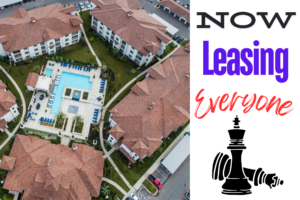
Maximizing occupancy and revenue hinges on setting and maintaining competitive market rents. Competitive properties are the major driver in determining rents, set by asset or operations management team or through revenue management software. That’s why rents in multifamily are often referred to as market rents right? The right competitive market rents draw prospects in, while pricing too high can deter them.
One of the most common missteps is a lack of timely response to pricing changes in the market. This is often due to not looking at the submarkets with the right lens by having an incomplete or inaccurate comp selection. Let’s consider additional criteria you can add to select the right comp set to price competitive market rents in any market.
Traditional comp identifiers:
Proximity – 1 to 2 miles from subject
Age – Built within 5 to 7 years of subject
Average unit square footage – Similar average sqft suggests a similar property unit type composition.
Unit count – Selecting a comp with a similar unit count is not always a good qualifier. More on this later.
Differentiators – Common area or unit amenities that are similar.
Not suggesting that any of the traditional comp identifiers are wrong. It’s important to note that effective comp selection isn’t selecting only properties that are just like the subject property. The objective is to understand the pricing vs. product that a prospect will encounter in your submarket and position your property to be competitive in the selection process.
Here’s 2 additional criteria sets to consider when selecting comps to improve competitive pricing:
Select comps with the Highest Unit Count – Selecting properties in the submarket that have the highest unit counts is simply statistics. Prospects are more likely to find availability at a property with 400 units vs. 100 units, so your property is more likely to compete with a larger property’s availability and pricing.
Select 2 to 3 properties that are a Class Above – These properties are the top of the submarket for your comp set. When your rents are in-line with theirs it may signal that you need to adjust rents to stay competitive in the submarket or risk losing prospects to these better equipped competitors. When experiencing dips in occupancy or forecasting high exposure these properties will often reduce rents until projected to stabilize, temporarily dipping into submarket positions of other asset classes.
Effective comp selection isn’t about finding identical properties but understanding all asset classes prospects encounter when shopping for an apartment in your area and how it stacks up competitively. There are of course many other factors in maintaining competitive submarket positioning, but when converting a prospect to a resident it comes down to how the prospect weighs availability and value against cost.
Asset NOI Consulting assists multifamily owners and operators. If you’d like assistance in implementing or improving your current system for setting rents and market positioning, Asset NOI helps owners and operators select comp sets, map their units to the submarket, set-up or optimize existing revenue management software, and select market analytics platforms that support maximized revenue opportunities. Contact me at shampton@AssetNOI.com for more details.

